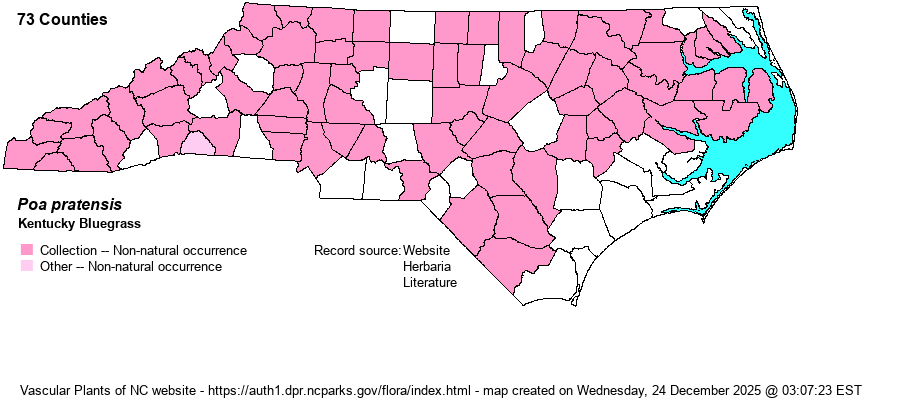| Author | L. | |
| Distribution | Nearly throughout the state; except uncommon on the Outer Banks/barrier islands, Sandhills proper, and outer Southern Coastal Plain.
Native to Europe; in N.A. native subspecies occur in the Arctic, with disjunct occurrences in the high Rockies and White Mountains; alien subspecies occur elsewhere except most of FL and TX. | |
| Abundance | Frequent to common throughout, except uncommon in the Sandhills proper and the Outer Banks. | |
| Habitat | Naturalized in forests, woodlands, wetlands, lawns, roadsides, pastures, disturbed soil. Widely planted for forage. | |
| Phenology | Flowering and fruiting April-August. | |
| Identification | Kentucky Bluegrass, despite its name, is not native to KY or anywhere in the southeastern U.S. Plants are perennial, rhizomatous and so are turf-forming, green or bluish green. Culms may reach 2 feet or more, with relatively open inflorescences and 2-7 branches per node. The florets have white wispy hairs at their base. The well-developed rhizomes separate it from our other bluegrasses, except P. cuspidata and P. compressa. | |
| Taxonomic Comments | The genus Poa contains some 500 species globally, about 70 in N.A. A typical Poa species has a number of basal leaves, few stem leaves, and a terminal, open inflorescence. The inflorescence is composed of well-spaced whorls of 2-6 skinny branches, usually with short side branchlets and these bearing spikelets. Branches may be strongly ascending, horizontal, or reflexed. Spikelets are composed of 2-6 florets and are generally laterally compressed. Each glume and lemma is acute to blunt, but seldom acuminate as in many Festuca species. Unlike Festuca and Bromus, most Poa species have a small wispy tuft of white hairs at the base of each floret. | |
| Other Common Name(s) | | |
| State Rank | SE | |
| Global Rank | G5 | |
| State Status | | |
| US Status | | |
| USACE-agcp | FACU link |
| USACE-emp | FACU link |

